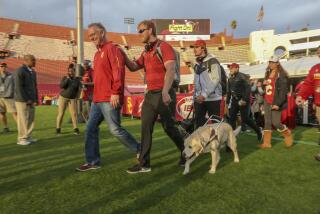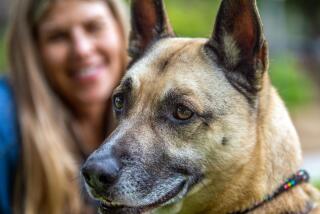Guiding Light
- Share via
Mary Stockstill has long put her trust in the Good Book. The two great Braille volumes beside the chair in which she might be found knitting a multicolored blanket or entertaining her grandchildren are an important source of light in her life. There is also her dog, Max, in whom she believes, and the typewriter in which she has come to believe, the Braille one I used to ask her about Max, a chocolate Labrador retriever, who is her eyes and ears.
Max is in “limited service.” Most of the blind who use dogs can communicate through the harness to the animal about what they hear in the way of dangers, especially traffic dangers. A dog who must concentrate on avoiding obstacles, especially ones he isn’t used to worrying about (such as overhead branches), can’t pay sufficient attention to traffic hazards. Handler and dog guide each other--not only should the dog refuse to obey a command that will take the handler into danger, the handler should refuse to follow the dog if she or he hears danger. Since Stockstill can’t hear, this team can’t negotiate traffic.
But this is some kind of limited service. I watched Stockstill work Max at night, alone on a residential street. He took her safely down the street, circumventing a pile of weeds and branches left carelessly on the sidewalk, which could have meant a fall, and stopped at the curb. He also glanced back nervously at me. Stockstill didn’t know why he was hesitating, only that his halt wasn’t the usual firm halt that signals the presence of a curb. He continued looking back at me each time she urged him forward. When we got back to the house, and could talk again through her Braille typewriter, she wondered if he had been distracted by barking dogs--if, that is, he had not worked responsibly while I watched.
I thought he had worked beautifully. There had been something suspicious for him to worry about--me, following the two of them in the dark as I scribbled into my notebook and muttered into my tape recorder. Not many young dogs would have kept their cool with such conflicting messages. How would you feel if the person you were supposed to be guiding were being trailed by a dubious-looking person from out of town with a tape recorder? I would want to call my mother or the cops or something.
Max, instead of calling his mother, just kept doing his job, which at that point had entailed keeping Stockstill out of the street, not letting her get lost, and watching me. She, deciding to trust Max, asked him to guide her home, which he did--still keeping a wary eye on me.
So, Max thinks for himself, but his human handlers don’t always appreciate his wisdom. There was the time, for example, out shopping, when Max decided it was too warm in the store and simply led Stockstill out. Her husband, Chuck, panicked, then found them outside the door. He said in the somewhat cross relief one feels under such circumstances, “I wasn’t through shopping!”
Mary said, “Well, Max decided you were.”
Stockstill became blind in 1939 at the age of 10. Her deafness “bottomed out” in 1959, which was also the year she thought she had to give up on having a dog, because there weren’t facilities training dogs then for a person both deaf and blind, at least not that the Stockstills could find. That is going on 30 years ago--years of I don’t know what grief, frustration and despair that go with being housebound and pretty much cut off. I don’t know much about all of that, in part because Mary Stockstill wouldn’t tell me about it. She said, “Just make Max look good.”
Well, that isn’t hard. He used to be, as Stockstill said, “just a puppy named Max. Now he’s Maximilian.”
For information about guide dogs like Maximilian, call International Guiding Eyes at (818) 362-5834.






